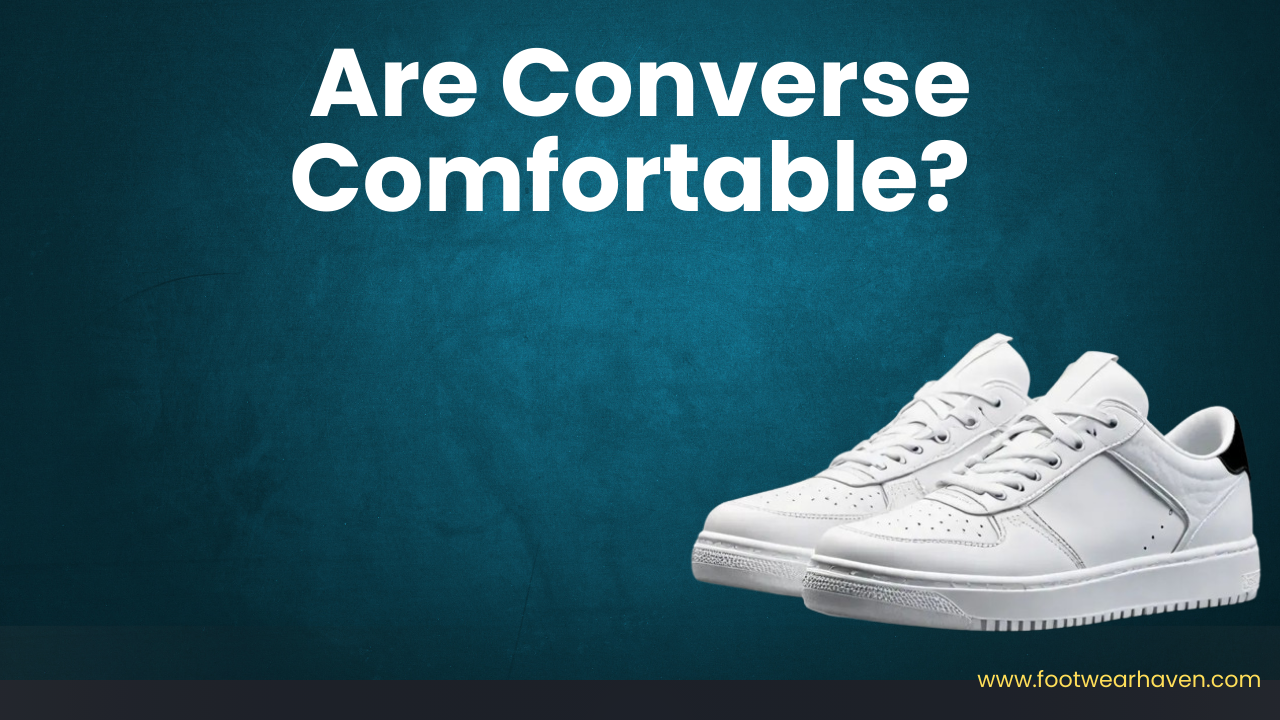“Are Converse comfortable?” is a common question, especially if you’re considering getting a new pair. We’ve thoroughly explored this topic to provide you with the best insights. Whether you’re a sneaker enthusiast or just looking for comfortable footwear, you’ll find all the answers here.
Quick Answer:
Converse shoes offer comfort for casual, short-term use, thanks to their lightweight and breathable design. However, due to limited arch support and cushioning, they are not ideal for long durations.
Want more details? In this guide, you’ll discover how comfortable Converse shoes really are and which models provide the most comfort. Let’s dive in.
Table of Contents
ToggleKey Takeaways

- Converse shoes are comfortable for everyday wear but aren’t suitable for prolonged use.
- Breaking in your Converse with thick socks or a shoe stretcher can enhance their comfort.
- Different Converse models offer varying levels of comfort, with Chuck 70s offering more cushioning than classic Chuck Taylors.
- Wearing thicker socks and adjusting the laces can improve fit and security.
- Converse shoes are less cushioned compared to brands like Nike and Adidas.
- Regular shoe rotation and using moleskin padding can reduce discomfort in certain situations.
Is Converse Comfortable? Understanding the Comfort Level
Converse shoes can be comfortable for casual, short-term use because of their lightweight and breathable design. However, for individuals needing additional support and cushioning, they may not be the best choice. This is why opinions on Converse comfort vary significantly.
Let’s explore why Converse shoes work well for short-term comfort.
Lightweight Design
One of the biggest reasons Converse are easy to wear is their lightweight construction, making them ideal for short outings or hanging out with friends. The materials used in their production, such as canvas and rubber, help keep the weight down.
During our research, we discovered that the most common materials in Converse shoes include:
- Canvas
- Rubber
These lightweight materials mean less fatigue on your feet, which is why many people find Converse to be ideal for casual wear.
Key Benefits of a Lightweight Design:
- Enhanced comfort for daily wear.
- Improved performance, aiding in agility and speed.
- Reduced fatigue over time.
- Greater flexibility, allowing for easier movement.
- Better breathability, keeping feet cool.
- Easier to pack, ideal for travel.
- Less strain on your joints.
- Sleek and stylish design.
- Quick drying in wet conditions.
Breathability
One notable feature of Converse shoes is their breathability. The canvas material often includes tiny holes that allow airflow, which is critical for keeping feet cool, especially on warmer days.
Nobody likes sweaty feet, right?
Breathable shoes like Converse help your feet stay dry, which in turn makes you feel more comfortable.
Breathability also helps prevent foot odor and blisters, making Converse a good choice for summer.
Flexible Sole
The rubber sole on Converse shoes is also a standout feature. It’s flexible, allowing your feet to move naturally. We observed that the sole bends with your foot, which is great for everyday activities such as walking or running errands.
A flexible sole encourages natural movement and minimizes the risk of injuries.
Why Are Converse Not Comfortable for Long Periods?
While Converse shoes offer short-term comfort, they fall short when worn for extended periods due to the following factors:
- Lack of arch support
- Minimal cushioning
- Flat sole design
- Thin materials that lack adequate padding
Let’s break down each factor in more detail.
Lack of Arch Support
The most significant issue with Converse is their lack of arch support. Arch support helps distribute your body weight evenly across your feet, reducing strain on your heels and back. Without it, you may experience discomfort, especially in your heels or arches.
Proper arch support keeps your feet in a natural position, minimizing strain on muscles and ligaments. Unfortunately, Converse doesn’t offer this support, making them unsuitable for long wear.
Insufficient Cushioning
Another drawback is the minimal cushioning in Converse soles. Cushioning acts as a shock absorber, protecting your feet with each step. Without sufficient cushioning, your feet endure more impact, especially on rough terrain.
Due to this, wearing Converse for long stretches can lead to soreness and foot fatigue.
Flat Sole Design
While the flat sole might look trendy, it’s not designed for long-term comfort. A flat sole lacks the elevation and contour needed to support your foot’s natural shape. Wearing Converse for too long could result in overpronation, where your foot rolls inward excessively.
Overpronation can lead to issues in your ankles, knees, and hips.
Materials That Lack Padding
The canvas and thin rubber used in Converse shoes don’t provide enough padding for long walks or standing on hard surfaces. The lack of padding makes it easy to feel every bump and crack beneath your feet, which can become uncomfortable after a while.
Minimal Heel Support
Another area where Converse shoes fall short is heel support. Proper heel cushioning helps stabilize your foot and absorb impact. Converse shoes lack this feature, causing heel discomfort after prolonged wear.
Narrow Fit
Many reviews highlight that Converse shoes have a narrow fit, which may be uncomfortable for those with wider feet. Tight-fitting shoes can lead to blisters and general foot pain. If you have wider feet, Converse might not be the best option for extended wear.
However, if you have normal-width feet, the break-in period can make them more comfortable over time.
Breaking in Your Converse: Important for Comfort
Breaking in your Converse is essential to make them more comfortable. It softens the material, making the shoes more flexible and a better fit. This process also helps prevent blisters.
Wearing Thick Socks
Thick socks can speed up the break-in process by providing extra padding. They gently stretch the material, making the shoes softer and preventing blisters. Start by wearing them around the house for short periods and gradually increase the time.
Using a Shoe Stretcher
A shoe stretcher can also help break in your Converse. It stretches the canvas material, making it less stiff. Leave the stretcher in overnight for optimal results.
Walking Around the House
Wearing your Converse indoors for short periods helps soften the material without exposing them to dirt. Start with 15-30 minutes, gradually increasing the duration to break them in comfortably.
Flexing the Shoes with Your Hands
Bending and twisting the shoes with your hands can help loosen stiff areas like the heel or toe box.
Using Shoe Inserts
Adding inserts can provide additional arch support and cushioning, especially during the break-in period. Inserts designed for arch support or heel cushioning can significantly enhance comfort.
How to Enhance the Comfort of Your Converse? Easy Tips
To improve the comfort of your Converse, you can:
- Add cushioned insoles
- Use heel pads
- Adjust the laces for a better fit
Let’s explore some more tips.
Add Cushioned Insoles
Insoles can make a big difference, providing extra padding and support, which is especially useful if you plan to wear your Converse for long hours.
Use Heel Pads
Heel pads help prevent blisters and add cushioning. Stick them inside your shoes for extra comfort.
Adjust the Laces
Tightening or loosening the laces can provide a more customized fit, preventing your feet from slipping inside the shoes.
Rotate Your Shoes
Wearing the same shoes every day can lead to discomfort. Rotating your footwear allows them to air out and regain their shape.
Use Moleskin Padding
Moleskin padding is a great way to prevent friction and blisters. Apply it to areas where you feel the most rubbing.





